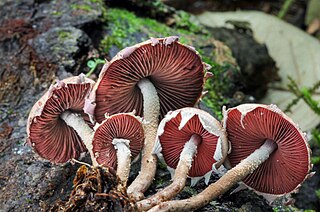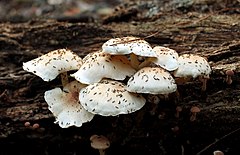
Coprinus is a small genus of mushroom-forming fungi consisting of Coprinus comatus - the shaggy ink cap (British) or shaggy mane (American) - and several of its close relatives. Until 2001, Coprinus was a large genus consisting of all agaric species in which the lamellae autodigested to release their spores. The black ink-like liquid this creates gave these species their common name "ink cap" (British) or "inky cap" (American).

Leucocoprinus is a genus of fungi in the family Agaricaceae. Its best-known member is the yellow pot-plant mushroom, found worldwide. The type species is Leucocoprinus cepistipes. The genus has a widespread distribution and contains about 40 species. It includes some highly derived cultivars grown by the Acromyrmex and Atta leaf-cutting ants in an evolved ant–fungus mutualism.
Crucispora is a genus of fungi in the family Agaricaceae. The genus, described by mycologist Egon Horak in 1971, contains two species found in New Zealand and Asia.

Cystodermella is a genus of fungi in the family Agaricaceae. The genus comprises about 12 species, noted for producing agaric fruit bodies, bearing a cap, white gills and stipe with a fine, ephemeral ring. The genus was devised by Harri Harmaja in 2002, dividing the older genus Cystoderma into three independent genera: Cystoderma, Ripartitella and Cystodermella largely on the basis of microscopic differences. Cystodermella species bear non-amyloid spores and sometimes cystidia. The spores, in contrast to Ripartitella are not echinulate.
Endolepiotula is a fungal genus in the family Agaricaceae. This is a monotypic genus, containing the single secotioid species Endolepiotula ruizlealii. This fungus was found in Mendoza Province, Argentina, growing in sandy soil in somewhat dry environment after rainfall.
Endoptychum is a genus of secotioid fungi in the family Agaricaceae. Like the majority of secotioid taxa, the individual species of Endoptychum are thought to be recent mutations from agaricoid species, hence, Endoptychum is likely not a valid monophyletic genus.

Gastropila is a genus of fungi in the family Agaricaceae. The genus, described in 1973, contains four puffball-like species distributed in the Americas.
Hiatulopsis is a genus of two species of fungi in the family Agaricaceae. The genus was circumscribed in 1967 by mycologists K. Grinling and Rolf Singer with H. amara as the type species. H. aureoflava was added to the genus by Singer in 1989.
Lycoperdopsis is a fungal genus in the family Agaricaceae. A monotypic genus, it contains the single gasteroid species Lycoperdopsis arcyrioides, described as new to science in 1900.

Melanophyllum is a genus of fungi in the family Agaricaceae. The widespread genus contains four species.

Montagnea is a genus of fungi in the family Agaricaceae. The genus has a widespread distribution in subtropical dry areas, and contains five species. Montagnea was circumscribed by Swedish mycologist Elias Magnus Fries in 1836.
Neosecotium is a genus of fungi in the family Agaricaceae. The genus was circumscribed in 1960 by American mycologists Rolf Singer and Alexander H. Smith. The type species, N. macrosporum, previously only known from the US, was recorded in Mexico in 2012.

Panaeolopsis is a genus of fungi in the family Agaricaceae. The genus has a widespread distribution and contains four species. Panaeolopsis was circumscribed by Rolf Singer in 1969 with P. sanmartiniana as the type species.
Phlebonema is a fungal genus in the family Agaricaceae. It is a monotypic genus, containing the single species Phlebonema chrysotingens, described by Roger Heim in 1929 from Madagascar. According to the Dictionary of the Fungi, the placement of this little-known genus in the Agaricaceae is uncertain.

Tulostoma is a genus of fungi in the family Agaricaceae. Species in the genus are commonly known as stalkballs, or stalked puffballs.
Smithiomyces is a genus of fungi in the family Agaricaceae. It was circumscribed by Rolf Singer in 1944. The type species, S. mexicanus, was formerly placed in Amanita, as well as the now obsolete Leucomyces and Venenarius. The genus was named to honor American mycologist Alexander H. Smith. S. dominicanus was described from the Dominican Republic in 2015.
Physocystidium is a genus of fungi in the Tricholomataceae family. This is a monotypic genus, containing the single species Physocystidium cinnamomeum. This species is found in Trinidad, and was originally described as new to science in 1951 as Collybia cinnamomea by mycologist R.W.G. Dennis; Rolf Singer transferred it to the then newly created genus Physocystidium in 1962.

Ripartitella brasiliensis is a species of fungus in the family Agaricaceae. It was originally described as new to science by Carlos Luigi Spegazzini in 1889. The fungus is found in the southwestern United States and Mexico, Central and South America, Africa, and the Bonin Islands of the western Pacific ocean. It fruits in clusters on the decaying wood of hardwood trees, especially oak.










